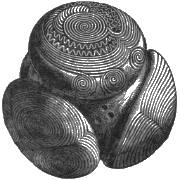Canmore Site 57623: LITTLE PINKERTON - DUNBAR - CIST (PERIOD UNASSIGNED), BEAKER
Description
| Site Name | LITTLE PINKERTON |
|---|---|
| Other Name(s) | n/a |
| Site Number | NT67NE 22 |
| Broad Class | FOOD PREPARATION AND CONSUMPTION, RELIGIOUS RITUAL AND FUNERARY, CONTAINER |
| Site Type(s) | CIST (PERIOD UNASSIGNED), BEAKER |
| NGR | NT 6967 7635 |
| NGR accuracy | NGR given to the nearest 10m |
| Local Authority | EAST LOTHIAN |
| Parish | DUNBAR |
| Record created | 1988-07-04 |
| Last updated | 2000-04-12 |
Archaeology Notes
NT67NE 22 6967 7635.
(NT 6967 7635) The top of a short cist, containing a portion of a beaker, was damaged by a tractor on West (Little) Pinkerton Farm, Broxburn in December 1938. 'The site is on the rising ground about a mile from the sea, to which there is a wide view. About 250 yards uphill to the south-west are the farm buildings of West Pinkerton.
There was no trace of a mould or cairn The cover-stone of the cist was 2 feet below the surface, but only one corner remained in position, the rest having broken and fallen in so long ago as not to leave the slightest depression on the surface. It was part of this corner that the tractor broke into. The cover had been about 2 inches thick and 6 feet 4 inches long, and seemed to extend 1 foot 9 inches on the north-west and 10 inches on the south-east beyond the side slabs, giving a breadth of at least 5 1/2 feet. Like the wall- slabs, which were 2 feet high, it was a single very even piece of yellow flaggy sandstone, probably carboniferous, which may have been quarried not far from the site of the grave. The long axis of the cist was 40 east of north,magnetic, i.e. towards the sea. The wall-slabs were 1 1/2 inch thick, except the south-west, which being only 1 inch had collapsed long ago. The south-west end- slab was 3 feet 1 inch wide and the north-east 2 feet 11 inches. They were 4 feet 9 inches apart on the north-west and 4 feet 6 inches on the south-east, and fitted fairly evenly, without any form of luting, between the side-slabs, which extended some 6 inches beyond them. The floor of the cist was almost entirely covered by a slab of grey flaggy sandstone 1/2 inch thick. Where this did not quite reach the sides, small additional pieces had been laid. This slab rested directly on the natural gravelly subsoil into which the cist had been sunk."
The remains of two middle-aged brachycranial males lay directly on the floor of the cist. The bones of one had been carefully laid on one side after skeletalisation to make room for the second which was in a contracted position on its left side, behind the shoulders of which had stood a beaker containing a browny deposit. The size of the cists suggests that the constructors may have anticipated the secondary interment, which may have taken place after an interval of a very few years. The beaker, as reconstructed, and now in the National Museum of Antiquities of Scotland (NMAS), measures 6 3/4" in height, 5 1/4" rim diameter, 5" at the bulge, and 3 1/2" at the base (Acc No: EG 75).
R B K Stevenson 1939
West Pinkerton, Broxburn, E Lothian. A short cist excavated by R B K Stevenson contained remains of two middle-aged brachycephalic males. The bones of one skeleton had been picked up individually and laid carefully aside after skeletalisation to make room for the second which lay in a contracted position on its left. Behind the shoulders lay an AC beaker. Proc Prehist Soc 1939
According to the farmer the cist described by Stevenson is still in situ although buried, in an arable field, at c. NT 6967 7635. He could not indicate the exact site.
Visited by OS (RD) 25 March 1966
Identifiers and Links to Other Records
This record has no links! Would you like to help?
| Identifier / External Link | Linked Record | Status | Comment |
|---|---|---|---|
| Canmore Site Number (legacy): NT67NE 22 | No linked record |
This area is visible only to logged in users.
